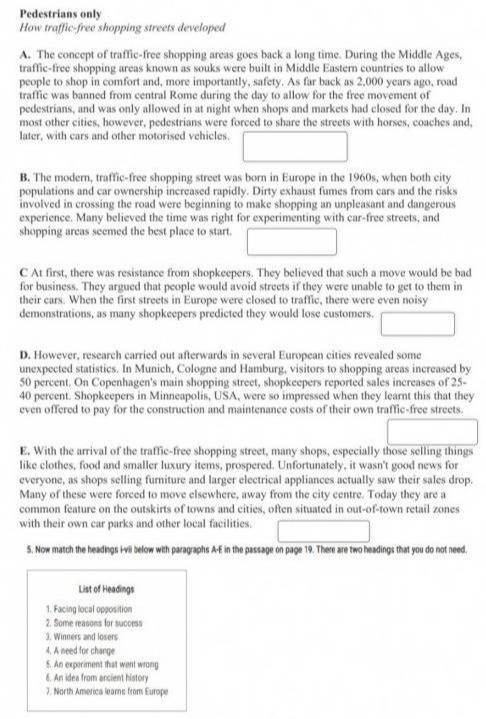Now match the headings i-vii below with paragraphs A - E in the passage on page 19. There are two headings that you do not need
----- Nội dung dịch tự động từ ảnh -----
Pedestrians only
How traffic-free shopping streets developed
A. The concept of traffic-free shopping areas goes back a long time. During the Middle Ages,
traffic-free shopping areas known as souks were built in Middle Eastern countries to allow
people to shop in comfort and, more importantly, safety. As far back as 2,000 years ago, road
traffic was banned from central Rome during the day to allow for the free movement of
pedestrians, and was only allowed in at night when shops and markets had closed for the day. In
most other cities, however, pedestrians were forced to share the streets with horses, coaches and,
later, with cars and other motorised vehicles.
B. The modern, traffic-free shopping street was born in Europe in the 1960s, when both city
populations and car ownership increased rapidly. Dirty exhaust fumes from cars and the risks
involved in crossing the road were beginning to make shopping an unpleasant and dangerous
experience. Many believed the time was right for experimenting with car-free streets, and
shopping areas seemed the best place to start.
C At first, there was resistance from shopkeepers. They believed that such a move would be bad
for business. They argued that people would avoid streets if they were unable to get to them in
their cars. When the first streets in Europe were closed to traffic, there were even noisy
demonstrations, as many shopkeepers predicted they would lose customers.
D. However, research carried out afterwards in several European cities revealed some
unexpected statistics. In Munich, Cologne and Hamburg, visitors to shopping areas increased by
50 percent. On Copenhagen's main shopping street, shopkeepers reported sales increases of 25-
40 percent. Shopkeepers in Minneapolis, USA, were so impressed when they learnt this that they
even offered to pay for the construction and maintenance costs of their own traffic-free streets.
E. With the arrival of the traffic-free shopping street, many shops, especially those selling things
like clothes, food and smaller luxury items, prospered. Unfortunately, it wasn't good news for
everyone, as shops selling furniture and larger electrical appliances actually saw their sales drop.
Many of these were forced to move elsewhere, away from the city centre. Today they are a
common feature on the outskirts of towns and cities, often situated in out-of-town retail zones
with their own car parks and other local facilities.
5. Now match the headings i-vii below with paragraphs A-E in the passage on page 19. There are two headings that you do not need.
List of Headings
1. Facing local opposition
2. Some reasons for success
3. Winners and losers
4. A need for change
5. An experiment that went wrong
6. An idea from ancient history
7. North America learns from Europe
SELIVEWORKSHEETS
Finish!!
1 trả lời
 16.324
16.324Trang chủ
Giải bài tập Online
Flashcard - Học & Chơi
Dịch thuật
Cộng đồng
Trắc nghiệm tri thức
Khảo sát ý kiến
Hỏi đáp tổng hợp
Đố vui
Đuổi hình bắt chữ
Quà tặng và trang trí
Truyện
Thơ văn danh ngôn
Xem lịch
Ca dao tục ngữ
Xem ảnh
Bản tin hướng nghiệp
Chia sẻ hàng ngày
Bảng xếp hạng
Bảng Huy hiệu
LIVE trực tuyến
Đề thi, kiểm tra, tài liệu học tập













 Xem thêm
Xem thêm 
 Thưởng th.10.2024
Thưởng th.10.2024 Bảng xếp hạng
Bảng xếp hạng